Language-learning app Duolingo (NASDAQ:DUOL) reported results ahead of analysts' expectations in Q4 FY2023, with revenue up 45.4% year on year to $151 million. Guidance for next quarter's revenue was also optimistic at $165.5 million at the midpoint, 3.9% above analysts' estimates. It made a GAAP profit of $0.26 per share, improving from its profit of $0.19 per share in the same quarter last year.
Duolingo (DUOL) Q4 FY2023 Highlights:
- Revenue: $151 million vs analyst estimates of $148.4 million (1.8% beat)
- EPS: $0.26 vs analyst estimates of $0.16 ($0.10 beat)
- Revenue Guidance for Q1 2024 is $165.5 million at the midpoint, above analyst estimates of $159.4 million (adjusted EBITDA guidance for the period also ahead of expectations)
- Management's revenue guidance for the upcoming financial year 2024 is $723.5 million at the midpoint, beating analyst estimates by 3.2% and implying 36.2% growth (vs 43.6% in FY2023) (adjusted EBITDA guidance for the period also ahead of expectations)
- Free Cash Flow of $47.67 million, up 42.4% from the previous quarter
- Gross Margin (GAAP): 73.1%, in line with the same quarter last year
- Paid Subscribers: 6.6 million, up 2.4 million year on year
- Market Capitalization: $8.17 billion
Founded by a Carnegie Mellon computer science professor and his Ph.D. student, Duolingo (NASDAQ:DUOL) is a mobile app helping people learn new languages.
The company offers courses in widely-spoken languages such as Spanish, Mandarin, and French as well as less-known ones like Navajo. Duolingo primarily operates through a mobile app that can be downloaded on the app store and uses gamification to engage its users - for example, the app motivates users by awarding points for streaks of consistent practice. Additionally, adaptive learning is used to personalize the learning experience, where content and difficulty are adjusted based on the student's progress and performance.
The pain points Duolingo addresses are the difficulty and expense of learning new languages. Traditional language courses require people to be physically present at a scheduled time and can really put a dent in the wallet. Classes might also move at a certain speed, which can be too fast or slow for certain learners. With Duolingo, users can learn wherever there is an internet connection, on their own schedule, and at their own pace. All this for free (ad-supported tier) or a reasonable cost.
The company utilizes both a free version (ad-supported tier) and a paid version. Its main source of revenue is from subscriptions, and there are various tiers with more expensive ones providing more courses, features, and practice or assessment materials. Duolingo also generates revenue through advertising, partnerships, and language proficiency tests where the company offers assessments that are accepted by many universities and institutions around the world. For example, the Duolingo English Test is used by thousands of universities and institutions worldwide as a measure of proficiency.
Consumer Subscription
Consumers today expect goods and services to be hyper-personalized and on demand. Whether it be what music they listen to, what movie they watch, or even finding a date, online consumer businesses are expected to delight their customers with simple user interfaces that magically fulfill demand. Subscription models have further increased usage and stickiness of many online consumer services.
Competitors offering language-learning services include Coursera (NYSE:COUR) and private companies Rosetta Stone, Babbel, Busuu, and Lingvist.Sales Growth
Duolingo's revenue growth over the last three years has been exceptional, averaging 50% annually. This quarter, Duolingo beat analysts' estimates and reported excellent 45.4% year-on-year revenue growth.
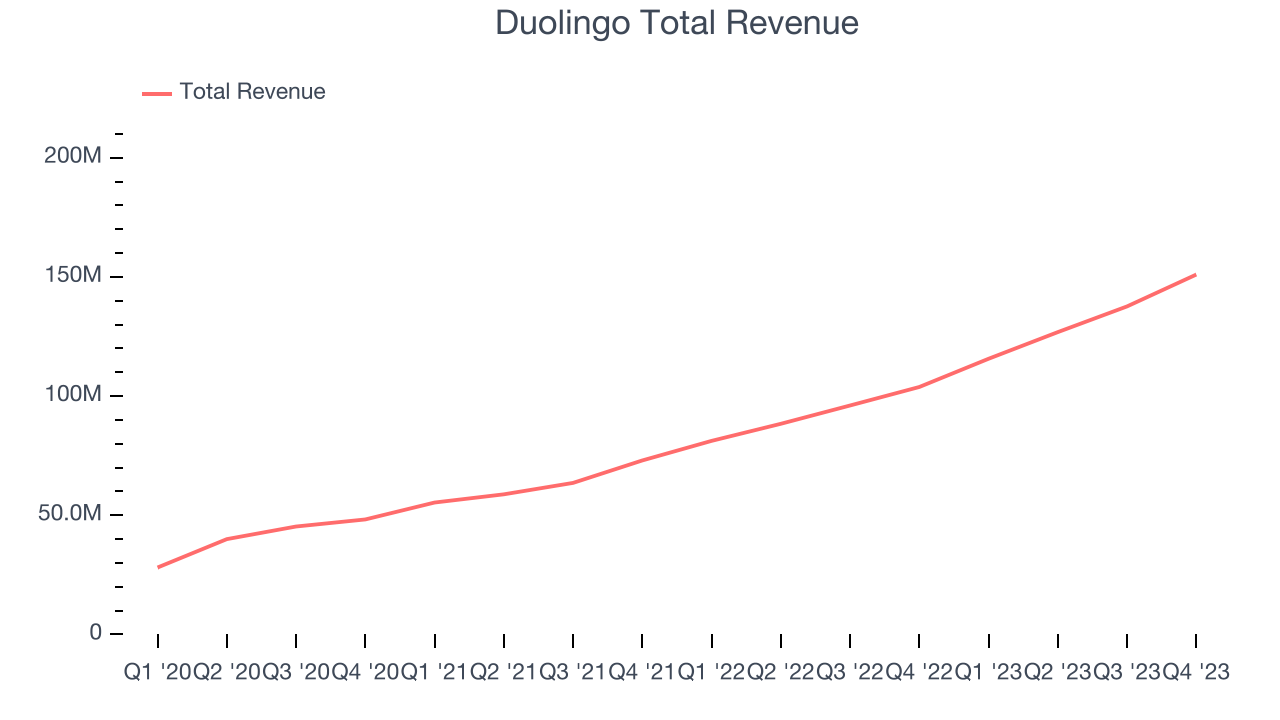
Guidance for the next quarter indicates Duolingo is expecting revenue to grow 43.1% year on year to $165.5 million, in line with the 42.4% year-on-year increase it recorded in the same quarter last year. For the upcoming financial year, management expects revenue to reach $723.5 million at the midpoint, representing 36.2% growth compared to the 43.6% increase in FY2023.
Usage Growth
As a subscription-based app, Duolingo generates revenue growth by expanding both its subscriber base and the amount each subscriber spends over time.
Over the last two years, Duolingo's users, a key performance metric for the company, grew 66.8% annually to 6.6 million. This is among the fastest growth rates of any consumer internet company, indicating that users are excited about its offerings.
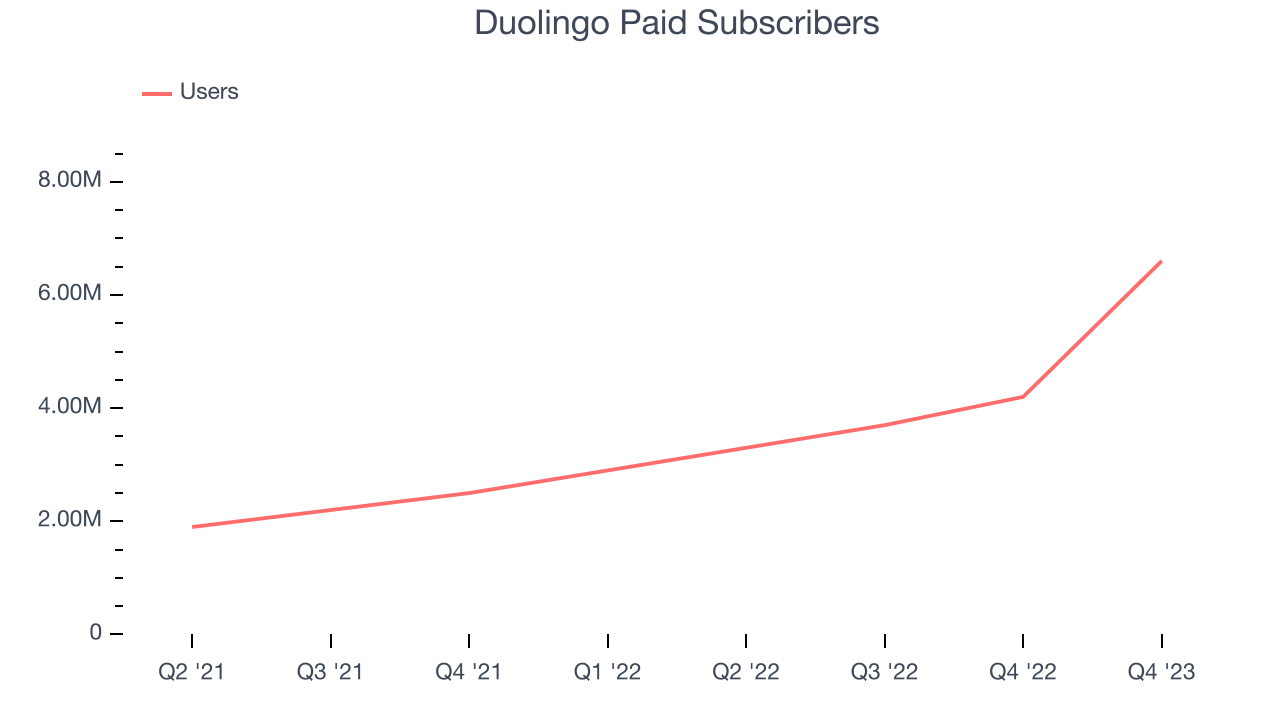
In Q4, Duolingo added 2.4 million users, translating into 57.1% year-on-year growth.
Revenue Per User
Average revenue per user (ARPU) is a critical metric to track for consumer internet businesses like Duolingo because it measures how much the average user spends. ARPU is also a key indicator of how valuable its users are (and can be over time). 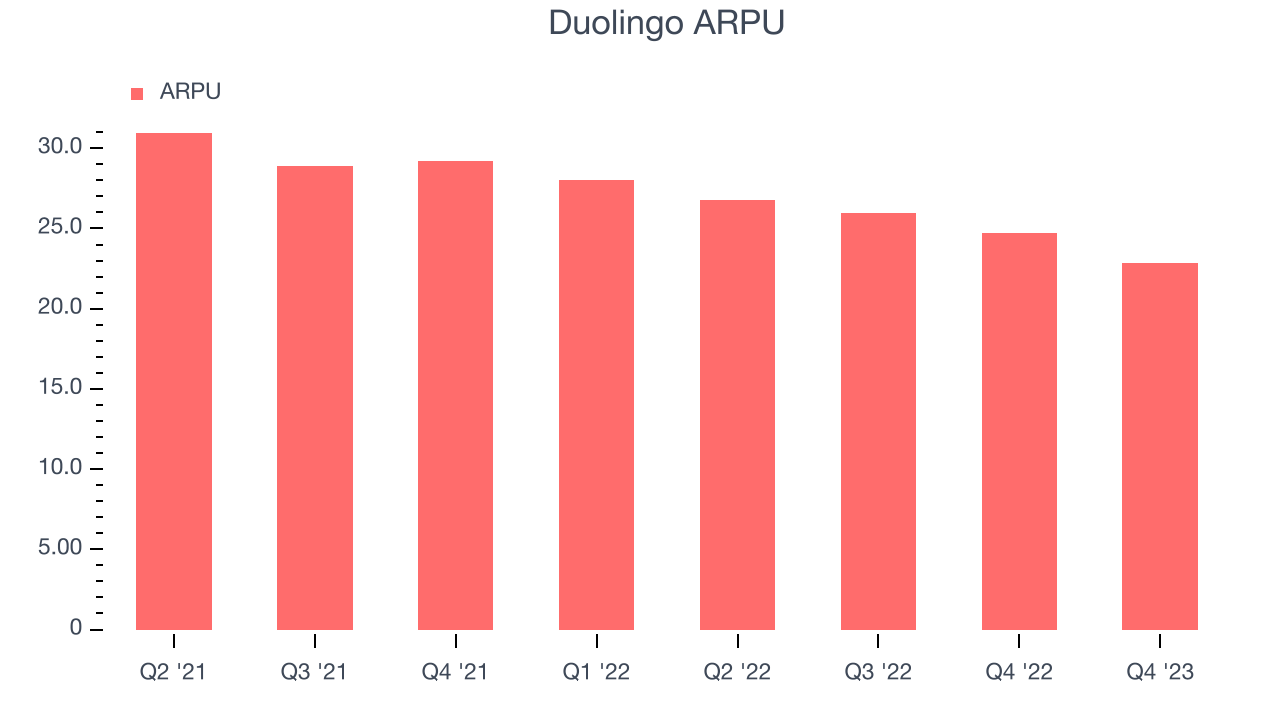
Duolingo's ARPU has declined over the last two years, averaging 11.6%. Although it's unfortunate to see the company lose its pricing power, it was still able to achieve strong user growth. This quarter, ARPU declined 7.5% year on year to $22.88 per user.
Pricing Power
A company's gross profit margin has a major impact on its ability to exert pricing power, develop new products, and invest in marketing. These factors may ultimately determine the winner in a competitive market, making it a critical metric to track for the long-term investor.
Duolingo's gross profit margin, which tells us how much money the company gets to keep after covering the base cost of its products and services, came in at 73.1% this quarter, down 0.1 percentage points year on year.
For internet subscription businesses like Duolingo, these aforementioned costs typically include customer service, data center and infrastructure expenses, and royalties and other content-related costs if the company's offering includes features such as video or music services. After paying for these expenses, Duolingo had $0.73 for every $1 in revenue to invest in marketing, talent, and the development of new products and services. 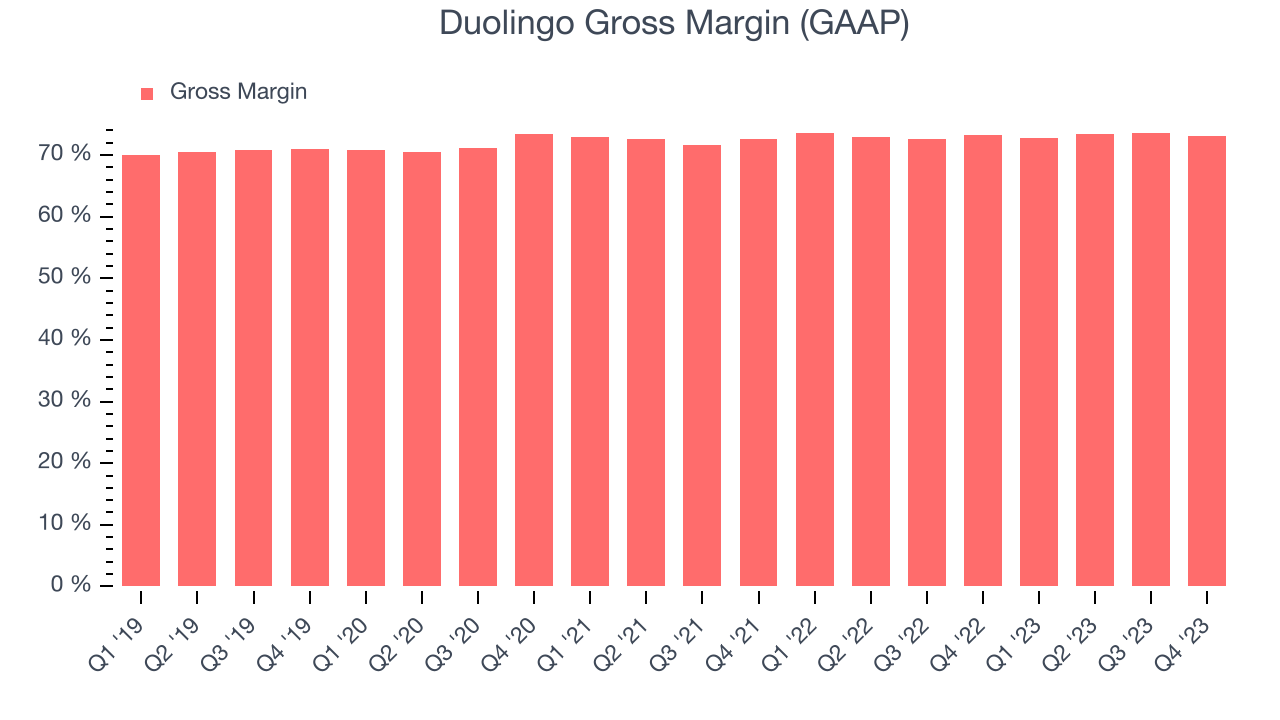
Duolingo's gross margins have been stable over the past year, averaging 73.2%. These robust unit economics, driven by the company's asset-lite business model and strong pricing power, are higher than its peer group and allow Duolingo to make more investments in product and marketing.
User Acquisition Efficiency
Unlike enterprise software that's typically sold by dedicated sales teams, consumer internet businesses like Duolingo grow from a combination of product virality, paid advertisement, and incentives.
Duolingo is extremely efficient at acquiring new users, spending only 19.5% of its gross profit on sales and marketing expenses over the last year. This efficiency indicates that it has a highly differentiated product offering and customer acquisition advantages from scale, giving Duolingo the freedom to invest its resources into new growth initiatives while maintaining optionality.
Profitability & Free Cash Flow
Investors frequently analyze operating income to understand a business's core profitability. Similar to operating income, adjusted EBITDA is the most common profitability metric for consumer internet companies because it removes various one-time or non-cash expenses, offering a more normalized view of a company's profit potential.
This quarter, Duolingo's EBITDA came in at $35.2 million, resulting in a 23.3% margin. Furthermore, Duolingo has shown strong profitability over the last four quarters, with average EBITDA margins of 17.6%.
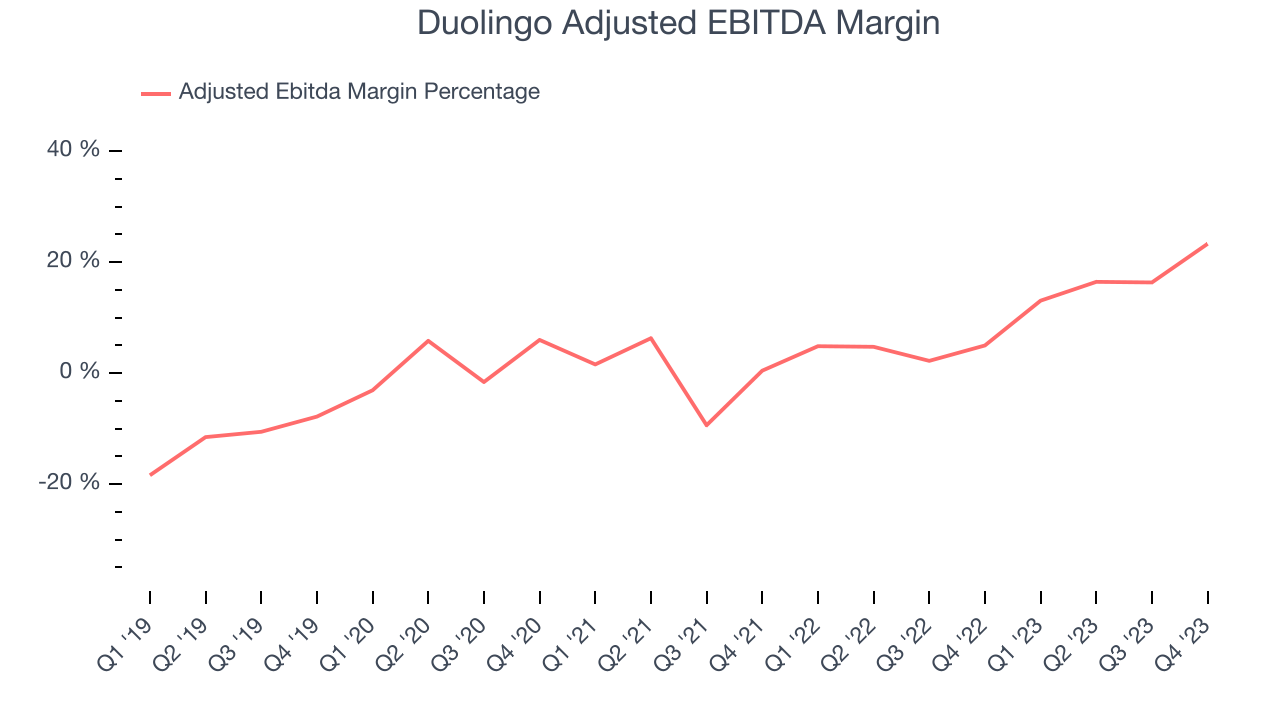
If you've followed StockStory for a while, you know that we emphasize free cash flow. Why, you ask? We believe that in the end, cash is king, and you can't use accounting profits to pay the bills. Duolingo's free cash flow came in at $47.67 million in Q4, up 322% year on year.
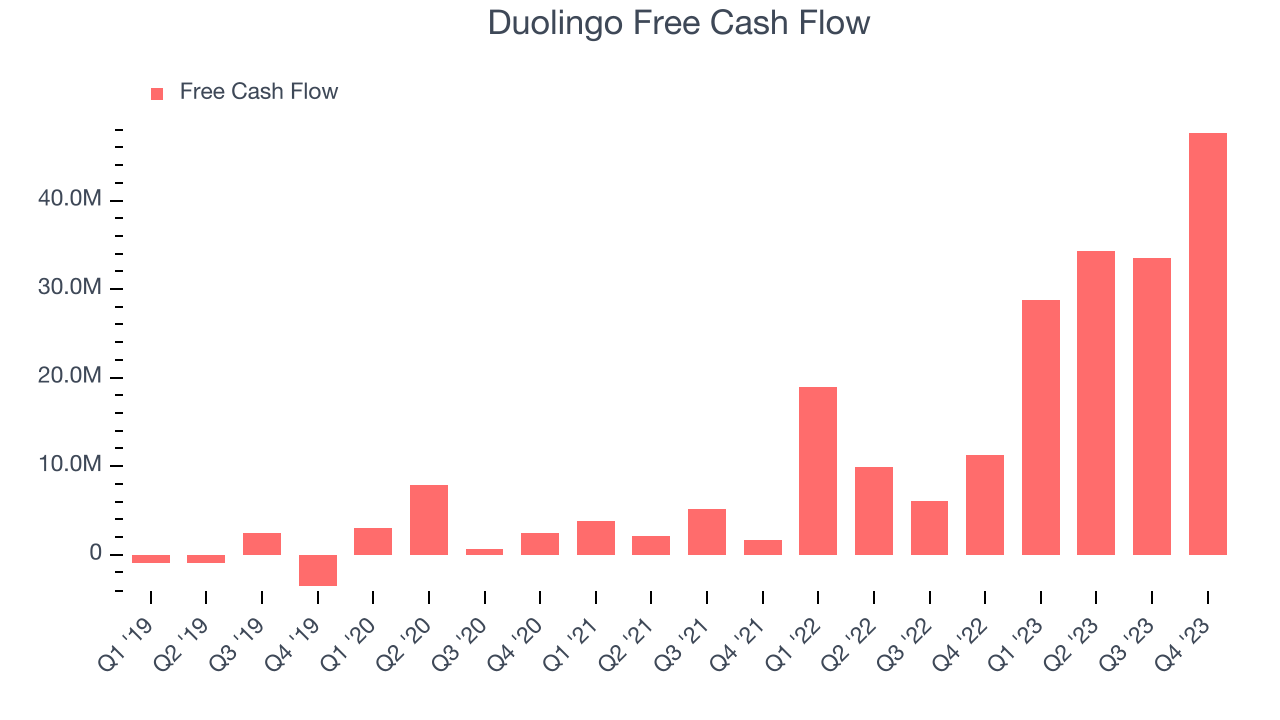
Duolingo has generated $144.3 million in free cash flow over the last 12 months, an eye-popping 27.2% of revenue. This robust FCF margin stems from its asset-lite business model, scale advantages, and strong competitive positioning, giving it the option to return capital to shareholders or reinvest in its business while maintaining a healthy cash balance.
Key Takeaways from Duolingo's Q4 Results
We were very impressed by Duolingo's robust user growth this quarter. We were also excited it produced strong revenue growth. Lastly, guidance for next quarter and the full year were ahead of expectations for both revenue and adjusted EBITDA. Zooming out, we think this was a great quarter that shareholders will appreciate. The stock is up 19.7% after reporting and currently trades at $234.43 per share.
Is Now The Time?
When considering an investment in Duolingo, investors should take into account its valuation and business qualities as well as what's happened in the latest quarter.
There are numerous reasons why we think Duolingo is one of the best consumer internet companies out there. First off, its revenue growth has been exceptional over the last three years. And while its ARPU has declined over the last two years, the good news is its powerful free cash flow generation enables it to stay ahead of the competition through consistent reinvestment of profits. On top of that, its growth in users has been strong.
Duolingo's price/gross profit ratio based on the next 12 months is 18.7x. Looking at the consumer internet landscape today, Duolingo's qualities really stand out, and we really like it at this price.
Wall Street analysts covering the company had a one-year price target of $214.56 per share right before these results (compared to the current share price of $234.43).
To get the best start with StockStory check out our most recent Stock picks, and then sign up to our earnings alerts by adding companies to your watchlist here. We typically have the quarterly earnings results analyzed within seconds of the data being released, and especially for the companies reporting pre-market, this often gives investors the chance to react to the results before the market has fully absorbed the information.
